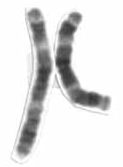Chromosome 3
(Redirected from Chromosome 3 (human))
Chromosome 3 is one of the 23 pairs of chromosomes in humans. People normally have two copies of this chromosome. Chromosome 3 spans almost 200 million base pairs (the building blocks of DNA) and represents about 6.5% of the total DNA in cells.
Structure[edit | edit source]
Chromosome 3 contains 3,000 to 3,100 genes that are responsible for a number of functions in the human body. The structure of chromosome 3, like other chromosomes, includes a short arm (p) and a long arm (q), which are connected by a centromere. The short arm is known as 3p while the long arm is 3q. Genes on chromosome 3 are critical for the development and function of many systems in the body.
Genetic Disorders[edit | edit source]
Several genetic disorders are linked to mutations in genes on chromosome 3. These include:
- Von Hippel-Lindau disease, a condition that predisposes individuals to develop tumors in multiple organs.
- Congenital heart disease, where mutations in certain genes on chromosome 3 can contribute to heart defects present at birth.
- Essential hypertension, where variations in genes on chromosome 3 are one of the many factors that can influence blood pressure levels.
- Type 2 diabetes, with some studies suggesting a link between certain genes on chromosome 3 and the risk of developing this condition.
Research[edit | edit source]
Research on chromosome 3 continues to uncover its many roles in human health and disease. Studies have focused on understanding the specific functions of genes located on this chromosome and how variations in these genes can lead to disease. This research is crucial for developing new treatments and therapies for conditions associated with chromosome 3.
See Also[edit | edit source]
Search WikiMD
Ad.Tired of being Overweight? Try W8MD's physician weight loss program.
Semaglutide (Ozempic / Wegovy and Tirzepatide (Mounjaro / Zepbound) available.
Advertise on WikiMD
|
WikiMD's Wellness Encyclopedia |
| Let Food Be Thy Medicine Medicine Thy Food - Hippocrates |
Translate this page: - East Asian
中文,
日本,
한국어,
South Asian
हिन्दी,
தமிழ்,
తెలుగు,
Urdu,
ಕನ್ನಡ,
Southeast Asian
Indonesian,
Vietnamese,
Thai,
မြန်မာဘာသာ,
বাংলা
European
español,
Deutsch,
français,
Greek,
português do Brasil,
polski,
română,
русский,
Nederlands,
norsk,
svenska,
suomi,
Italian
Middle Eastern & African
عربى,
Turkish,
Persian,
Hebrew,
Afrikaans,
isiZulu,
Kiswahili,
Other
Bulgarian,
Hungarian,
Czech,
Swedish,
മലയാളം,
मराठी,
ਪੰਜਾਬੀ,
ગુજરાતી,
Portuguese,
Ukrainian
Medical Disclaimer: WikiMD is not a substitute for professional medical advice. The information on WikiMD is provided as an information resource only, may be incorrect, outdated or misleading, and is not to be used or relied on for any diagnostic or treatment purposes. Please consult your health care provider before making any healthcare decisions or for guidance about a specific medical condition. WikiMD expressly disclaims responsibility, and shall have no liability, for any damages, loss, injury, or liability whatsoever suffered as a result of your reliance on the information contained in this site. By visiting this site you agree to the foregoing terms and conditions, which may from time to time be changed or supplemented by WikiMD. If you do not agree to the foregoing terms and conditions, you should not enter or use this site. See full disclaimer.
Credits:Most images are courtesy of Wikimedia commons, and templates, categories Wikipedia, licensed under CC BY SA or similar.
Contributors: Prab R. Tumpati, MD

